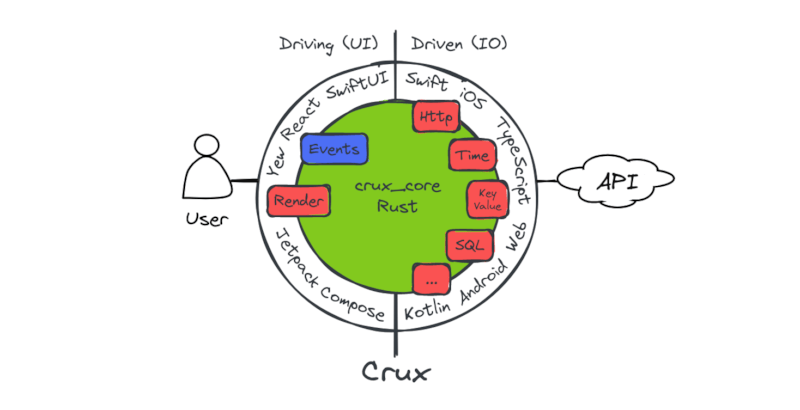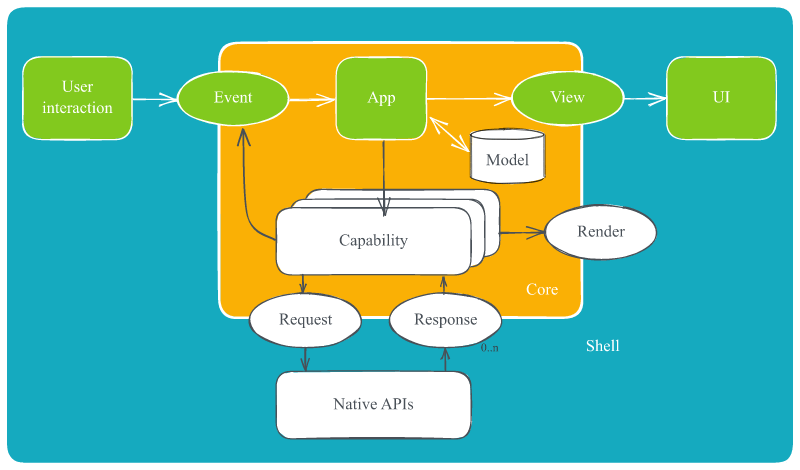40 releases (13 breaking)
| 0.14.0 | Apr 9, 2025 |
|---|---|
| 0.12.2 | Mar 21, 2025 |
| 0.10.0 | Oct 23, 2024 |
| 0.8.0 | May 23, 2024 |
| 0.1.1 | Nov 18, 2022 |
#1 in #cross-platform-ui
7,778 downloads per month
Used in 4 crates
290KB
4.5K
SLoC
Crux · 



Watch the introductory talk | Read the book | Read API docs | Join Zulip community
Cross-platform app development in Rust
- Shared Core for Behavior - Crux helps you share your app's business logic and behavior across mobile (iOS/Android) and web — as a single reusable core built with Rust.
- Thin Shell for UI - Crux recognizes that the best experiences are built with modern declarative frameworks such as SwiftUI, Jetpack Compose, React/Vue, or a WebAssembly based framework (like Leptos, or Yew) — however, it aims to keep this UI layer as thin as it can be, with all other work done by the shared core.
- Type Generation - the interface with the core has static type checking across languages — types and serialization code are generated for Swift, Kotlin and TypeScript. Rust shells can import the core directly.
- Managed effects - Side effects such as calling an API are captured as values and executed by the Shell. The core stays side-effect free, making it portable across platforms and allowing high-level user journey tests to run in milliseconds (rather than minutes or even hours)
Getting Started
Learn how to use Crux in your project.
Read the API documentation
Watch the introductory talk at the recent Rust Nation 2023 conference in London.
You can also join the friendly conversation on our Zulip channel.
[!NOTE] Crux is pre 1.0 and under active development. It is production-ready, but occasional breaking changes to the API can be expected. We do our best to limit the extent of these and provide a smooth, gradual migration path
Architectural Overview
Crux has managed side-effects, it strictly separates pure computational tasks from tasks that cause side effects. This is similar to the way Elm works.
Side-effect-free core
In the above diagram, the inner "Core" is compiled and linked to the outer "Shell" on each platform as a library:
- On iOS as a native static library
- On Android as a dynamic library using Java Native Access
- In a browser as a WebAssembly module
In fact, because WebAssembly (Wasm) is one of the compilation targets, the core must remain side-effect free, due to the sandboxed nature of the Wasm runtime environment.
As such, the core is completely isolated and secure against software supply-chain attacks, as it has no access to any external APIs. All it can do is perform pure calculations and keep internal state.
Following the Elm architecture, the core defines the key component types within the application:
Event— anenumdescribing the events which the core can handleModel— describes the internal state of the applicationEffect– the kinds of side-effects the core will requestViewModel— represents information that should be displayed to the user
The first three are tied together by the update function, familiar from Elm,
Redux or other event sourcing architectures, which currently has this type
signature:
fn update(
&self,
msg: Event,
model: &mut Model,
_caps: &Capabilities, // soon to be deprecated
) -> Command<Effect, Event> {
// ...
}
The job of the update function is to process an Event, update the model
accordingly, and potentially request some side-effects.
[!NOTE] The
CapabilityAPI is being deprecated in favour of a more flexibleCommandAPI.To learn more about the new
CommandAPI, see the page in the book that describes Managed Effects, or look at examples/counter.
Application Shell
The enclosing platform native "Shell" is written using the language appropriate for the platform, and acts as the runtime environment within which all the non-pure tasks are performed. From the perspective of the core, the shell is the platform on which the core runs.
Testing
Tests can act as another Shell, exercising the Core in the same way a real app would, observing and resolving the requested effects and checking the model and view model are correct. No need for fakes, mocks or stubs.
Communication Between the Application Shell and the Core
Following the Elm architecture, the interface with the core is message based.
To perform any task that creates a side-effect (such as an HTTP
call or random number generation), the core must request it from the shell as an Effect.
Effects support fire-and-forget, request/response, and streaming semantics.
Crux has a concept of Capabilities — reusable interfaces for common side-effects which can be used in the Core as a more ergonomic API.
The only built-in capability is Render. But this repository contains a few
capabilities at various stages of maturity, and you can easily write your own if
you want to:

Published capabilities
Render(ask UI to render the ViewModel) — source, built-in tocrux_core, request onlyHttp(full HTTP implementation based on the Surf API) — source, crate, request/responseKeyValue(basic key-value store API) — source, crate, request/responseTime(get current time, notify after duration, notify at instant) — source, crate, request/responsePlatform(get the current platform) — source, crate, request/response
Example custom capabilities
SSE(basic Server-Sent Events) — source, request/streamingPubSub(pub sub with streaming) — source, request/response/streamingDelay— part of tutorial in the book
Foreign Function Interface with type generation
The core API interface is very minimal:
process_event: Event -> Vec<Request>- processes a user interaction event and potentially responds with capability requests. This is the API for the driving side in the above diagram.handle_response: (uuid, SomeResponse) -> Vec<Request>- handles the response from the capability and potentially follows up with further requests. This is the API for the driven side in the above diagram.view: () -> ViewModel- provides the shell with the current data for displaying user interface
The Foreign Function Interface allowing the shell to call the above functions is provided by Mozilla's UniFFI on a mobile device, or in the browser, by wasm-pack.
In order to both send more complex data than UniFFI currently supports, and enforce the message passing semantics, all messages are serialized, sent across the boundary, then deserialized using serde-generate which also provides type generation for the foreign (non-Rust) languages.
This means that changes to types in the core, especially the Event and
Request types, propagate out into the shell implementations and cause type
errors where appropriate (such as an exhaustive match on an enum check).
Message Types
Three types of message are exchanged between the application and the core.
- Messages of type
Eventare sent from the Shell to the Core in response to an event happening in the user interface (the driving side). They start a potential sequence of further message exchanges between the shell and the core. Messages are passed on unchanged. - Messages of type
Requestare sent from the Core to the Shell to request the execution of some side-effect-inducing task. The Core responds with zero or moreRequestmessages after receiving anEventmessage (the driven side). - Response messages are sent from the Shell to the Core carrying the result of an earlier request.
Request messages contain the inputs for the requested side-effect, along with
a id used by the core to pair requests and their responses together. The
exact mechanics are not important, but it is important for the request's id
to be passed on to the corresponding response.
Example Message Exchange Cycle
A typical message exchange cycle may look like this:
- User interaction occurs in the Shell, which results in an event
- The Shell handles this event by constructing an
Event - The Shell calls the Core's
process_eventfunction passing theEventas an argument - The Core performs the required processing, updating both its inner state and the view model
- The Core returns one or more
Requestmessages to the Shell (inside an enum tagging the type of request)
In the simplest case, the Core will respond to an Event by returning the
single Request - render.
This requests that the Shell re-renders the user interface. When Render is the
only response from the Core, the message cycle has completed and the Core has
now "settled".
In more complex cases however, the Core may well return multiple Requests;
each of which instructs the Shell to perform a side-effect-inducing task such
as:
- Make a network call, or
- Fetch the current date/time stamp, or
- Perform biometric authentication, or
- Obtain an image from the camera, or
- Whatever else you can think of...
Many of these side-effecting-inducing tasks are asynchronous. The Shell is
responsible for passing responses back to the core (to the handle_response
function), which may respond with further requests.
This exchange continues until the core stops requesting further side-effects
(typically the last side-effect requested would again be Render).
Sponsors
Crux is kindly sponsored by the following organizations. Your help is very much appreciated.
Red Badger Consulting Limited

Red Badger is the digital product consultancy trusted by blue chips and global brands. Our product design and technical pedigree allow us to craft high-impact digital products customers want. We use modern engineering approaches to deliver sustainable change. And embed digital capabilities to power continuous innovation.
Zulip
Zulip is an open-source modern team chat app designed to keep both live and asynchronous conversations organized.
Zulip sponsor Crux by providing our Zulip server — thank you Zulip!
Dependencies
~2.5–4MB
~83K SLoC

